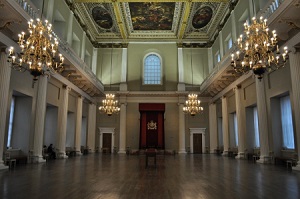Palladian architecture
Palladian architecture was inspired by the designs of the Venetian architect Andrea Palladio and his 1570 book, I Quattro Libri dell'Architettura (Four Books of Architecture).
The architect Inigo Jones introduced the style to England after a trip he made to Italy in 1613-14, where he had been inspired by the Renaissance architecture flourishing there, in particular the works of Palladio.
Among the finest examples of Jones’ work are the Queen’s Chapel at St. James Palace (1623), Banqueting House at Whitehall (1619-22) (see top and bottom images), and the Queen’s House at Greenwich (1635).
Following the English Civil War (1642-51), the country endured a prolonged period of austerity, during which Palladianism went into decline.
During the mid-17th and early-18th centuries it resurged in popularity, not only in England but also in countries such as America and Prussia. It was around this time that Palladio’s book was translated by Giacomo Leoni, at the same time as a series of books reproducing the designs of Inigo Jones.
Palladian architecture continued to be popular throughout the 19th and early-20th centuries, although it was immersed within the ascendant movement of Neoclassical architecture. In contrast with Palladianism, which followed Palladio’s Renaissance-era interpretations of classical forms and details, Neoclassicism attempted to interpret them directly from antiquity.
Palladian designs were based on the symmetry and perspective of classical architecture, particularly the temples of the Ancient Greeks and Romans. It was characterised by proportions based on mathematics rather than ornament and its classical facades.
Some of the defining features of Palladianism include:
- Corinthian columns.
- Decorative motifs such as masked faces and scallop shells.
- Pediments used over doors and windows, both external and internal.
- Terms – free-standing stones representing the head and upper torso of the Roman god Terminus, on top of a pillar.
[edit] Related articles on Designing Buildings
- 25 best buildings in London.
- Antiquities.
- Architectural styles.
- Baroque architecture.
- Beaux Arts style.
- Egyptian hall.
- Elements of classical columns.
- English architectural stylistic periods.
- Entasis.
- Georgian.
- Jacobean architecture.
- Neoclassical architecture.
- Pediment.
- Regency style.
- Rococo.
- Stuart architecture.
- The White House.
Featured articles and news
Homes England creates largest housing-led site in the North
Successful, 34 hectare land acquisition with the residential allocation now completed.
Scottish apprenticeship training proposals
General support although better accountability and transparency is sought.
The history of building regulations
A story of belated action in response to crisis.
Moisture, fire safety and emerging trends in living walls
How wet is your wall?
Current policy explained and newly published consultation by the UK and Welsh Governments.
British architecture 1919–39. Book review.
Conservation of listed prefabs in Moseley.
Energy industry calls for urgent reform.
Heritage staff wellbeing at work survey.
A five minute introduction.
50th Golden anniversary ECA Edmundson apprentice award
Showcasing the very best electrotechnical and engineering services for half a century.
Welsh government consults on HRBs and reg changes
Seeking feedback on a new regulatory regime and a broad range of issues.
CIOB Client Guide (2nd edition) March 2025
Free download covering statutory dutyholder roles under the Building Safety Act and much more.
Minister quizzed, as responsibility transfers to MHCLG and BSR publishes new building control guidance.
UK environmental regulations reform 2025
Amid wider new approaches to ensure regulators and regulation support growth.
BSRIA Statutory Compliance Inspection Checklist
BG80/2025 now significantly updated to include requirements related to important changes in legislation.
























